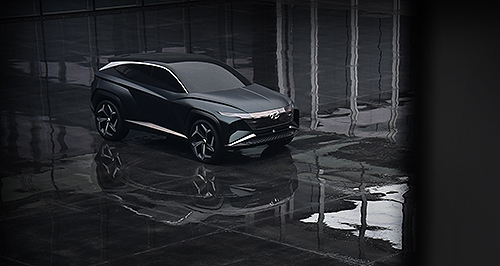Future models - Hyundai - Vision T ConceptLA show: Hyundai plugs Vision T SUV conceptPlug-in hybrid Vision T concept expected to morph into next Tucson mid-size SUV26 Nov 2019 HYUNDAI unveiled a plug-in hybrid SUV concept at the Los Angeles motor show last week that advances the styling of its hydrogen fuel-cell Nexo and conventional combustion-engined Santa Fe models into what is hinted to preview the next-generation Tucson that is due for release in the next 12 months.
Details of what is expected to be a beefed-up version of the Ioniq’s petrol-electric drivetrain option remain scarce as the Vision T is more of a design study, although it is less of a leap from existing Hyundai styling conventions than the angular and retro-futuristic 45 electric hatchback concept shown at Frankfurt in September.
Highly sculpted flanks give the Vision T a muscular look, while the squared-off wheelarches are bolder and more confident versions of the Gandini-style shapes applied to the current Tucson –a family resemblance that isarguably the biggest hint as to this concept’s future production incarnation.
The South Korean car-maker describes this look as “a vision of the new urban adventurer SUV design direction”.
Another feature that could make it from show car to showroom is the “parametric air shutter” grille made up of cells that can individually open and close in sequence to precisely control cooling airflow and aerodynamics for optimised efficiency.
Similarly the “hidden signature” headlight design integrated into the grille uses one-way mirrors in what looks like an extension of the grille unless the LEDs behind are illuminated.
In contrast to the bulges and creases of the Vision T’s lower body is a more minimalist glasshouse with narrow shut lines and thin pillars designed to give the impression of a seamless, one-piece window.
The panoramic glass roof is discreetly etched with a pattern that forms the Hyundai emblem.From the rear, the Vision T has a heavily haunched appearance with distinct ‘hips’ caused by a jutting crease that starts at the front door and becomes more pronounced above the rear wheelarches, which themselves are dramatically flared.
The grille design is mimicked by the tail-light cluster that is linked by a slim light strip running from edge to edge of the tailgate, which is topped by a prominent roof spoiler with triangular high-level brake light while a two-level splitter type design dominates the rear bumper.
Hyundai says the rear clusters “follow a prescribed light extinguishing sequence” that ends with the company’s logo in illuminated form.
Charging status is also displayed in lights, creating a full circle around the socket when its battery is full.
Apart from being a hefty 2014mm wide –while lacking any exterior mirrors or doorhandles in typical concept car style –the Vision T’s dimensions could feasibly be transplanted to the next-generation Tucson.
Currently at the small end of the medium SUV segment, the Tucson is 4480mm long, while the Vision T is sized closer to the Toyota RAV4 at 4610mm in length.The Vision T’s 2804mm wheelbase is substantially longer than the current Tucson and even eclipses that of the Hyundai Santa Fe large SUV that stretches 2765mm between the axles.
As a result, the concept has tiny overhangs that may not make it to the production version.Height-wise, the Vision T is 1704mm tall compared with 1660mm for the Tucson and 1690mm for a RAV4, probably owing to its oversized concept car wheels, behind which are orange brake callipers.
The lifecycle for Hyundai models tends to last between five and six years, so given the current Tucson was revealed at the 2015 Geneva motor show it fits that an all-new model based on the Vision T will break cover some time next year.
Hyundai included a diesel-electric plug-in hybrid prototype with 48-volt lithium-ion battery pack in with the original Tucson reveal at Geneva in 2015, along with a more conventional series hybrid that was also based around a diesel engine.
Popularity of the current Tucson has begun to wane, with salesslumping 19.2 per cent last year and down 6.9 per cent year-to-date.
It remains Hyundai’s second-best seller with 15,555 reported deliveries to the end of October, after the i30 small hatch on 24,104 units (+0.3%).
Overall Hyundai sales are 8.2 per cent down, on 73,944 units to the end of October.  Read more12th of November 2019  Hyundai Australia appoints new CEOFresh team at the top of Hyundai in Australia as Jun Heo appointed chief executive12th of November 2019  World-first noise tech revealed by HyundaiHyundai’s industry-leading noise-cancelling system to debut on new Genesis model8th of November 2019  Improved Hyundai Ioniq Electric to increase salesBetter range should help Hyundai Ioniq Electric outsell plug-in, hybrid siblings |
Click to shareHyundai modelsResearch Hyundai Motor industry news |
















Facebook Twitter Instagram